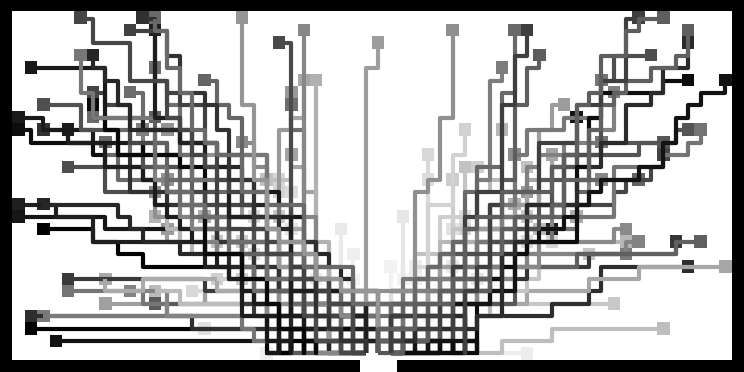Try a cellular automata¶
Cellular Automata models are microscopic in the sense that agents are represented individually, but they are also natively discrete in both space and time. In space, agents are identified to particles located in cells of a fixed cartesian grid, with an exclusion rule (one particle at most in each cell). In time, the evolution consists of a succession of steps, i.e. positions of particles are updated one after the other, in a stochastic manner.
Reference : [MF2018] Chapter 5.
A cellular automata example can be found in the directory
cromosim/examples/cellular_automata/
and can be run with:
python3 cellular_automata.py --json input.json
Results:
Cellular automata : simple example, an evacuation

The lines represent the paths of all the individuals
Code:
cromosim/examples/cellular_automata/cellular_automata.py
# Authors:
# Sylvain Faure <sylvain.faure@math.u-psud.fr>
# Bertrand Maury <bertrand.maury@math.u-psud.fr>
#
# cromosim/examples/cellular_automata/cellular_automata.py
# python cellular_automata.py --json input.json
#
# License: GPL
import sys, os
from cromosim import *
from cromosim.ca import *
from optparse import OptionParser
import json
"""
python3 cellular_automata.py --json input.json
"""
parser = OptionParser(usage="usage: %prog [options] filename",version="%prog 1.0")
parser.add_option('--json',dest="jsonfilename",default="input.json",type="string",
action="store",help="Input json filename")
opt, remainder = parser.parse_args()
print("===> JSON filename = ",opt.jsonfilename)
with open(opt.jsonfilename) as json_file:
input = json.load(json_file)
"""
Get parameters from json file :
name: string
Domain name
prefix: string
Folder name to store the results
background: string
Image file used as background
px: float
Pixel size in meters (also called space step)
width: integer
Domain width (equal to the width of the background image)
height: integer
Domain height (equal to the height of the background image)
wall_lines : list of numpy arrays
Polylines used to build walls, [ [[x0,x1,x2,...],[y0,y1,y2,...]],... ]
wall_ellipses : list of numpy arrays
Ellipses used to build walls, [ [x_center,y_center, width, height, \
angle_in_degrees_anti-clockwise],... ]
wall_polygons : list of numpy arrays
Polygons used to build walls, [ [[x0,x1,x2,...],[y0,y1,y2,...]],... ]
wall_lines : list of numpy arrays
Polylines used to build walls, [ [[x0,x1,x2,...],[y0,y1,y2,...]],... ]
door_lines: list of numpy arrays
Polylines used to build doors, [ [[x0,x1,x2,...],[y0,y1,y2,...]],... ]
update_strategy: string
Rules used to move the individuals : 'sequential' or 'parallel'
seed: integer
Random seed which can be used to reproduce a random selection if >0
Np: integer
Number of persons
kappa: float
Parameter for Static Floor Field
Tf: float
Final time
dt: float
Time step
drawper: integer
The results will be displayed every "drawper" iterations
"""
name = input["name"]
prefix = input["prefix"]
if not os.path.exists(prefix):
os.makedirs(prefix)
background = input["background"]
px = input["px"]
width = input["width"]
height = input["height"]
wall_lines = input["wall_lines"]
wall_ellipses = input["wall_ellipses"]
wall_polygons = input["wall_polygons"]
door_lines = input["door_lines"]
seed = input["seed"]
Np = input["Np"]
update_strategy = input["update_strategy"]
kappa = input["kappa"]
Tf = input["Tf"]
dt = input["dt"]
drawper = input["drawper"]
print("===> Number of persons = ",Np)
print("===> Final time, Tf = ",Tf)
print("===> Time step, dt = ",dt)
print("===> To draw the results each drawper iterations, drawper = ",drawper)
"""
Build the Domain
"""
## To create an Domain object
if (background==""):
dom = Domain(name=name, pixel_size=px, width=width, height=height)
else:
dom = Domain(name=name, background=background, pixel_size=px)
## To add lines : Line2D(xdata, ydata, linewidth)
for xy in wall_lines:
line = Line2D( xy[0],xy[1], linewidth=1)
dom.add_wall(line)
## To add ellipses : Ellipse( (x_center,y_center), width, height,
## angle_in_degrees_anti-clockwise )
for e in wall_ellipses:
ellipse = Ellipse( (e[0], e[1]), e[2], e[3], e[4])
dom.add_wall(ellipse)
## To add polygons : Polygon( xy )
for p in wall_polygons:
polygon = Polygon(p)
dom.add_wall(polygon)
## To add doors :
for xy in door_lines:
line = Line2D( xy[0],xy[1], linewidth=1)
dom.add_door(line)
## To build the domain : background + shapes
dom.build_domain()
## To compute the distance to the walls
dom.compute_wall_distance()
## To compute the desired velocity
dom.compute_desired_velocity()
## To show the domain dimensions
print("===> Domain : ",dom)
print("===> Wall lines : ",wall_lines)
print("===> Door lines : ",door_lines)
"""
Initialization
"""
## Current time
t = 0
people = sp.ma.MaskedArray(sp.zeros((height,width),dtype=int), mask=dom.mask)
## Number of cells
Nc = height*width - dom.mask_id[0].shape[0]
print("===> Number of cells = ",Nc)
## People initialisation taking to account masked positions
rng = sp.random.RandomState()
if (seed>0):
rng = sp.random.RandomState(seed)
print("===> seed = ",rng.get_state()[1][0])
s = 0
if (Nc<height*width):
imin = dom.mask_id[0].min()+1
imax = dom.mask_id[0].max()-1
jmin = dom.mask_id[1].min()+1
jmax = dom.mask_id[1].max()-1
else:
imin = 0; imax = height
jmin = 0; jmax = width
while (s != Np):
#people.data[rng.randint(imin,imax+1,Np-s),
# rng.randint(jmin+int(0.25*(jmax-jmin)),
# jmax-int(0.25*(jmax-jmin))+1,Np-s)] = 1
people.data[rng.randint(imin,imax+1,Np-s),rng.randint(jmin,jmax+1,Np-s)] = 1
s = sp.sum(people)
ind = sp.where(people==1)
people_ij = -sp.ones((Np,2),dtype=int)# i(0<=i<=height-1) j(0<=j<=width-1)
people_ij[:,0] = ind[0]
people_ij[:,1] = ind[1]
#print("===> Init : people_ij = ",people_ij)
## Array to store the results
results = sp.copy(people_ij).reshape((Np,2,1))
## Static Floor Field
weight = sp.exp(-kappa*dom.door_distance)
cc = 0
iter = 0
plot_people_according_to_current_door_distance(1, people, dom,
savefig=True, filename=prefix+'/cellular_automata_'+str(iter).zfill(6)+'.png')
#plot_people_according_to_initial_door_distance(2, people, dom, results)
while (sp.sum(people)>0):
if (update_strategy == "parallel"):
people, people_ij = parallel_update(people, people_ij, weight,
friction = 0)
elif (update_strategy == "sequential"):
people, people_ij = sequential_update(people, people_ij, weight,
shuffle='random', randomstate = rng)
else:
print("Bad value for update strategy... EXIT")
sys.exit()
people, people_ij = exit(dom, people, people_ij)
results = sp.concatenate((results,people_ij.reshape((Np,2,1))), axis=2)
t += dt
cc += 1
iter += 1
print("========> time = ",t," number of persons = ",sp.sum(people))
if (cc>=drawper):
plot_people_according_to_current_door_distance(1, people, dom,
savefig=True, filename=prefix+'/cellular_automata_'+str(iter).zfill(6)+'.png')
#plot_people_according_to_initial_door_distance(2, people, dom, results)
cc = 0
#plot_people_according_to_current_door_distance(1, people, dom)
#plot_people_according_to_initial_door_distance(2, people, dom, results)
#plot_people_according_to_exit_times(3, dt, people, dom, results)
plot_people_paths(2, dt, px, people, dom, results,
savefig=True, filename=prefix+'/cellular_automata_paths.png')
plt.show()